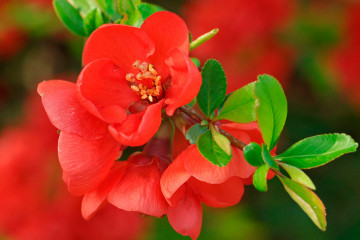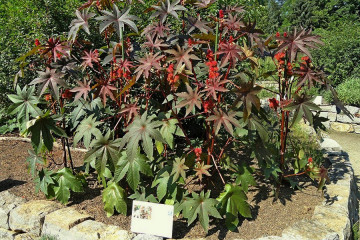Oxalis ordinary - description of the plant
Content:
Oxide ordinary is a storehouse of useful substances, a real natural pharmacy. The plant is inconspicuous, hiding in the forest. It is suitable for decorating garden spaces, growing quickly and requiring little maintenance. Its leaves, flowers attract with tenderness, graceful simplicity.
Detailed description
Common oxalis (Latin calls the plant oxalis acetosella, oxalis) is a herbaceous perennial. Representative of the genus Oxalis. The people sometimes mention such names as cuckoo clover, hare cabbage, forest sorrel. It is no coincidence that the grass received such names.
The foliage, consisting of three interconnected heart-shaped leaves, resembles a clover. The greens taste pleasant, sweet and sour. This is a cross between garden sourness (sorrel) and fresh early cabbage.
The description of the oxalis ordinary begins with the fact that the plant lives in groups, forming a light green carpet. Usually occupies a space of two or more square meters. The heaped habitat is due to biological characteristics. The root system consists of thin threads spreading in different directions.
The color of the rhizome is brick reddish brown. Most of the rhizome is infected with fungi. Because of this, tiny bubbles, swellings are visible on it.
What does oxalis look like? Long petioles grow from the rhizome, at the ends of which there are leaves. There are no stems. Both leaves and flower arrows form on the petioles. Oxalis grass is low. It grows from 4 to 8 cm.
Miniature flowers bloom in May. They bloom until mid-June. The petals are white. Tiny purple streaks are present. White can be diluted with a shallow yellow tint. Flowers are pollinated by insects, and there are also self-pollinating specimens.
When the oxalis berry ripens and turns into a fruit, the tiny seeds are removed from the mother plant. This is due to a special cunning mechanism hidden in the shell of the fruit. When the seeds ripen, the fruit capsules burst, the seed scatters. The force of the "explosion" allows them to fly away "from home" by 1.5 meters.
Many people ask the question "is the oxalis listed in the Red Book or not?" Experts claim that the plant is listed in the red books of some regions, for example, Murmansk, Magadan, Penza regions.
Distribution and habitats
Oxalis acetosella can be found in many parts of the planet Earth, for example, in North America, Europe, Asia. In Russia, wild oxalis is a full-fledged inhabitant of forest areas throughout the middle zone, Siberia, and the eastern part of the country. In the south, it is too hot, but even here you can find individual meadows of miniature grass.
The best place for hare cabbage is in the woodland. Mixed forests are suitable for her, as well as deciduous or coniferous and even mountainous ones. She will feel good wherever there is loose fertile soil, wet, there is a slight coolness. Shade-loving kukushkin clover. Therefore, you need to look for it under the dense crowns of trees. According to scientific data, for good development, the grass needs only about 1-2% of the light per day.
Another characteristic indicator of the acid habitat is the proximity of swamps, ponds, rivers, streams. Where oxalis grows, you can find other well-known forest herbs:
- nettle;
- burdock;
- fireweed;
- violet;
- marsh wild rosemary;
- ivan tea, etc.
Kislitsa has an important property - unpretentiousness, it doesn't really matter who grows nearby. In this regard, it is the dominant, if necessary, it can reclaim any territory.
Growing
An unpretentious, useful look was looked after by gardeners. Now the common sour cherry is grown as an ornamental crop. It decorates landscape solutions in many gardens, is an attribute of alpine slides, acts as a lawn under trees and in open areas.
Some gardeners even grow sorrel in pots at home, on verandas, balconies. Domestic specimens also demonstrate survivability.
Before you start growing oxalis acetosella, there are some important conditions you should be familiar with. Despite the fact that the plant is patient and tenacious, some mistakes of the gardener can destroy it.
Experienced gardeners recommend that before starting to plant oxalis in their garden or on the windowsill, pay attention to five main points. Among them:
- choice of location;
- soil preparation;
- choice of fertilizers;
- proper care.
Seat selection
Much depends on which flowerbed or garden bed will grow. For example, if you plant it in the central part of the site, where the bright sun bakes, then the green carpet will turn yellow and dry out. Another thing is shaded corners, for example, an oxalis near a tree, under a wide crown, feels good. Another option is in the form of the lower tier of flower beds, where light-loving crops rise above the tender grass.
Oxalis in the forest fills large areas due to the peculiarity of seed dispersion. This cannot be allowed in the garden. Otherwise, the cuckoo clover will turn into a weed that is difficult to get rid of. It is recommended to clean Oxalis away from the beds with vegetables, salad greens, potatoes.
The soil
The plant loves light, fertile soils, in which there is enough peat. Therefore, before planting, you should dilute too clayey heavy soil with sand, add any kind of peat, compost there. Attention should be paid to the acidity of the soil. It should be neutral. Slightly acidic soil is also allowed for planting.
Fertilizers
For good growth, the plant needs nutrients. Oxalis is a wild forest plant. The forest soil is nutritious and fertile. Therefore, it is best to fertilize beautiful grass in the garden. For this, complex mineral mixtures for flower crops are suitable. For example:
- Nitrofoska;
- Ammophos;
- Nitroammofosk;
- Diammofosk, etc.
Such drugs for oxalis acetosella are used according to the instructions, while the dose should be halved. This is done due to the insignificant green mass compared to other colors.
Care
Care consists in moderate watering (1 time in 1-2 days), spraying (since the plant cannot survive in dry air). Fertilize it every 1-1.5 months.
In regions with harsh winters, sour cherry growing in the open air can be covered with mulch, for example, fallen leaves, peat. In this case, any winter is not terrible for a perennial.
Reproduction
Rabbit cabbage reproduces in different ways. For example:
- seeds;
- tubers, bulbs;
- cuttings (petioles, leaves).
Planting seeds, tubers in open ground should not be earlier than the onset of May. Petioles, leaves are first placed in a glass of water or in a pot of soil mixture. Experiments with propagation by cuttings are best carried out in an apartment.
Chemical composition and properties of the species
What is oxalis? This is a natural pharmacy. The chemical composition is striking with useful elements. Even by taste, you can understand that a variety of organic acids are present in the form:
- amber;
- wine;
- lemon;
- oxalic;
- fumaric.
There are many vitamins in green foliage and petioles. Among which stand out:
- rutin;
- vitamin C;
- vitamin A, K, etc.
Oxalis plant whose description contains information about the small size and special tenderness of the leaves, due to its chemical composition, is very useful. If you believe traditional medicine, then the plant is able to have a healing effect for the following ailments:
- menstrual, head, muscle cramps;
- lack of appetite and anorexia;
- avitaminosis;
- diarrhea;
- problems in the gastrointestinal tract;
- pneumonia;
- high fever during a cold;
- heart disease.
Oxide will cure stomatitis, abscesses on the skin and mucous membranes, heartburn. It is a good diuretic. Also removes bile. Leaves and flowers are eaten. They are added to salads, decorate second courses, soups, drinks. If you add a few blades of grass to tea, it will be enriched with vitamins and will acquire a pleasant sour taste.
The use of hare cabbage in traditional medicine
In folk medicine, oxalis acetosella is used in several forms. For example:
- squeezing out juice;
- cooking gruel;
- preparation of tincture;
- making decoctions.
Juice from green mass helps with impaired metabolism, problems in the stomach and intestines, as well as to raise the tone in the body. It is also used to get rid of worms. If you rinse your mouth with juice, you can heal from stomatitis, ulcers, abscesses.
Gruel heals wounds, removes swelling, removes bruises. The tincture is usually drunk in the course. It helps with serious diseases of the gastrointestinal tract, liver, and scurvy. Broths are indicated for colds, stomach cancer and the elimination of helminths.
The best recipes for healing remedies
Juice and honey
100 g of green mass are washed, dipped in boiling water for 30 seconds. Then grind in a blender or meat grinder. The juice is squeezed out. The resulting drink is diluted with boiled water. The proportion is one to one. In the morning, afternoon and evening, the drink is taken 10 g (teaspoon).
It is important to consume the juice along with fresh honey. About 5 g of honey per teaspoon of juice. This folk recipe is suitable for removing worms.
For efficiency, you need to organize a weekly course, which can be repeated again after 4-5 weeks.
Gruel from wounds, suppuration
Oxalis and plantain leaves are ground. The resulting composition is applied to the affected areas of the body. You can fix the gruel with a bandage.
Strong infusion
15-40 g of leaves are washed, put in a glass jar and 300 ml of boiling water are poured. The jar is wrapped in a towel and left for 60-90 minutes. The infusion is taken in a glass every one and a half to two hours. This cocktail will help with severe food poisoning, hangover.
Milk broth
15-30 g of green mass is placed in a bowl, where 300 ml of fat milk. Everything is cooked for 5 minutes, then it is infused for 120-150 minutes. The broth is taken in 2 tablespoons every 2-3 hours. Milk brew helps with colds, fever.
Oxalis ordinary will adorn any site, window sill. This unpretentious plant does not require careful maintenance.Possessing beneficial properties, hare cabbage heals a number of ailments. The plant is the main ingredient in many folk recipes. Do not forget about the other side of the coin - grass is dangerous in large quantities.






















